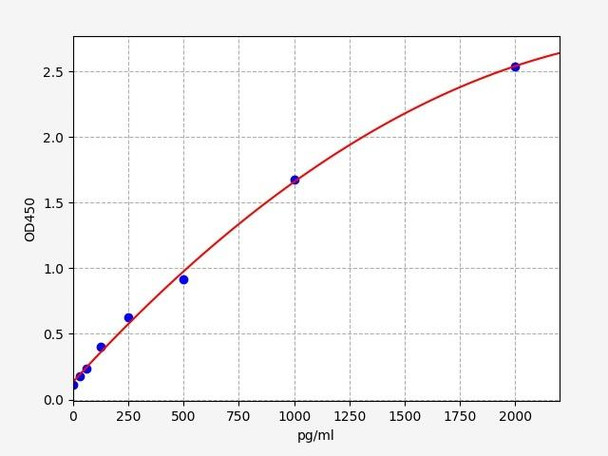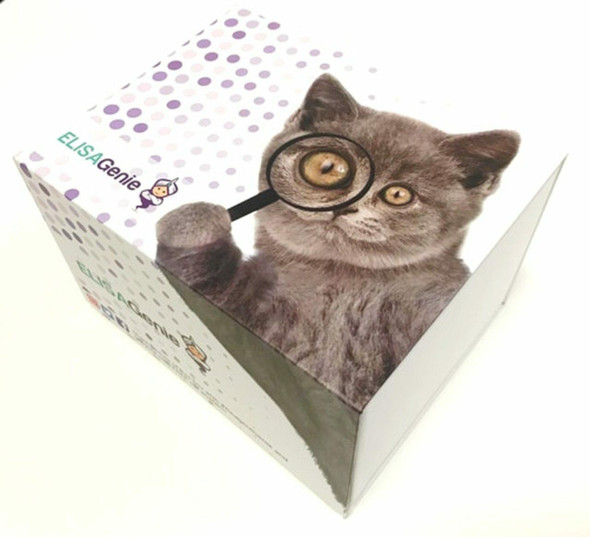Human SATB2 (Special AT-rich sequence-binding protein 2) ELISA Kit (HUFI06654)
- SKU:
- HUFI06654
- Product Type:
- ELISA Kit
- Size:
- 96 Assays
- Uniprot:
- Q9UPW6
- Sensitivity:
- 18.75pg/ml
- Range:
- 31.25-2000pg/ml
- ELISA Type:
- Sandwich
- Synonyms:
- DNA-binding protein SATB2, SATB2, KIAA1034, Special AT-rich sequence-binding protein 2
- Reactivity:
- Human
Description
Human SATB2 (Special AT-rich sequence-binding protein 2) ELISA Kit
The Human SATB2 (Special AT-rich Sequence Binding Protein 2) ELISA Kit is a reliable tool for detecting SATB2 levels in human samples such as serum, plasma, and cell culture supernatants. This kit offers high sensitivity and specificity, ensuring accurate and reproducible results for various research applications.SATB2 is a key protein that functions in gene regulation, chromatin organization, and cell differentiation. It plays a crucial role in development, particularly in the central nervous system and craniofacial structures.
Dysregulation of SATB2 has been linked to certain developmental disorders and cancers, highlighting its importance as a biomarker for studying these conditions and exploring targeted therapies.Overall, the Human SATB2 ELISA Kit provides researchers with a valuable tool for investigating the role of SATB2 in various biological processes and disease states, ultimately contributing to advancements in our understanding of human health and disease.
| Product Name: | Human SATB2 (Special AT-rich sequence-binding protein 2) ELISA Kit |
| Product Code: | HUFI06654 |
| Size: | 96 Assays |
| Alias: | DNA-binding protein SATB2 ELISA Kit, SATB2 ELISA Kit, KIAA1034 ELISA Kit, Special AT-rich sequence-binding protein 2 ELISA Kit |
| Detection method: | Sandwich ELISA, Double Antibody |
| Application: | This immunoassay kit allows for the in vitro quantitative determination of Human SATB2 (Special AT-rich sequence-binding protein 2) concentrations in serum plasma and other biological fluids. |
| Sensitivity: | < 18.75pg/ml |
| Range: | 31.25-2000pg/ml |
| Storage: | 4°C for 6 months |
| Note: | For Research Use Only |
| Recovery: | Matrices listed below were spiked with certain level of Human SATB2 (Special AT-rich sequence-binding protein 2) and the recovery rates were calculated by comparing the measured value to the expected amount of Human SATB2 (Special AT-rich sequence-binding protein 2) in samples. | ||||||||||||||||
| |||||||||||||||||
| Linearity: | The linearity of the kit was assayed by testing samples spiked with appropriate concentration of Human SATB2 (Special AT-rich sequence-binding protein 2) and their serial dilutions. The results were demonstrated by the percentage of calculated concentration to the expected. | ||||||||||||||||
| |||||||||||||||||
| CV(%): | Intra-Assay: CV<8% Inter-Assay: CV<10% |
| Component | Quantity | Storage |
| ELISA Microplate (Dismountable) | 8×12 strips | 4°C for 6 months |
| Lyophilized Standard | 2 | 4°C/-20°C |
| Sample/Standard Dilution Buffer | 20ml | 4°C |
| Biotin-labeled Antibody(Concentrated) | 120ul | 4°C (Protect from light) |
| Antibody Dilution Buffer | 10ml | 4°C |
| HRP-Streptavidin Conjugate(SABC) | 120ul | 4°C (Protect from light) |
| SABC Dilution Buffer | 10ml | 4°C |
| TMB Substrate | 10ml | 4°C (Protect from light) |
| Stop Solution | 10ml | 4°C |
| Wash Buffer(25X) | 30ml | 4°C |
| Plate Sealer | 5 | - |
Other materials and equipment required:
- Microplate reader with 450 nm wavelength filter
- Multichannel Pipette, Pipette, microcentrifuge tubes and disposable pipette tips
- Incubator
- Deionized or distilled water
- Absorbent paper
- Buffer resevoir
| UniProt Protein Function: | SATB2: Binds to DNA, at nuclear matrix- or scaffold-associated regions. Thought to recognize the sugar-phosphate structure of double-stranded DNA. Transcription factor controlling nuclear gene expression, by binding to matrix attachment regions (MARs) of DNA and inducing a local chromatin-loop remodeling. Acts as a docking site for several chromatin remodeling enzymes and also by recruiting corepressors (HDACs) or coactivators (HATs) directly to promoters and enhancers. Required for the initiation of the upper- layer neurons (UL1) specific genetic program and for the inactivation of deep-layer neurons (DL) and UL2 specific genes, probably by modulating BCL11B expression. Repressor of Ctip2 and regulatory determinant of corticocortical connections in the developing cerebral cortex. May play an important role in palate formation. Acts as a molecular node in a transcriptional network regulating skeletal development and osteoblast differentiation. Chromosomal aberrations involving SATB2 are found in isolated cleft palate. Translocation t(2;7); translocation t(2;11). Defects in SATB2 are a cause of cleft palate isolated (CPI). A congenital fissure of the soft and/or hard palate, due to faulty fusion. Isolated cleft palate is not associated with cleft lips. Some patients may manifest other craniofacial dysmorphic features, mental retardation, and osteoporosis. A chromosomal aberration involving SATB2 is found in a patient with classical features of Toriello-Carey syndrome. Translocation t(2;14)(q33;q22). Belongs to the CUT homeobox family. |
| UniProt Protein Details: | Protein type:DNA-binding Chromosomal Location of Human Ortholog: 2q33 Cellular Component: nucleoplasm; transcription factor complex; nuclear matrix; cytoplasm; histone deacetylase complex Molecular Function:protein binding; sequence-specific DNA binding; chromatin binding Biological Process: chromatin remodeling; transcription, DNA-dependent; commitment of a neuronal cell to a specific type of neuron in the forebrain; cartilage development; neuron migration; positive regulation of transcription from RNA polymerase II promoter; negative regulation of transcription from RNA polymerase II promoter; palate development; embryonic pattern specification; osteoblast development; embryonic skeletal morphogenesis Disease: Glass Syndrome |
| UniProt Code: | Q9UPW6 |
| NCBI GenInfo Identifier: | 13634020 |
| NCBI Gene ID: | |
| NCBI Accession: | Q9UPW6.2 |
| Molecular Weight: | 81kDa |
| NCBI Full Name: | DNA-binding protein SATB2 |
| UniProt Protein Name: | DNA-binding protein SATB2 |
| UniProt Synonym Protein Names: | Special AT-rich sequence-binding protein 2 |
| Protein Family: | DNA-binding protein |
| UniProt Gene Name: | SATB2 |
| UniProt Entry Name: | SATB2_HUMAN |
*Note: Protocols are specific to each batch/lot. For the correct instructions please follow the protocol included in your kit.
Before adding to wells, equilibrate the SABC working solution and TMB substrate for at least 30 min at 37 °C. When diluting samples and reagents, they must be mixed completely and evenly. It is recommended to plot a standard curve for each test.
| Step | Protocol |
| 1. | Set standard, test sample and control (zero) wells on the pre-coated plate respectively, and then, record their positions. It is recommended to measure each standard and sample in duplicate. Wash plate 2 times before adding standard, sample and control (zero) wells! |
| 2. | Aliquot 0.1ml standard solutions into the standard wells. |
| 3. | Add 0.1 ml of Sample / Standard dilution buffer into the control (zero) well. |
| 4. | Add 0.1 ml of properly diluted sample ( Human serum, plasma, tissue homogenates and other biological fluids.) into test sample wells. |
| 5. | Seal the plate with a cover and incubate at 37 °C for 90 min. |
| 6. | Remove the cover and discard the plate content, clap the plate on the absorbent filter papers or other absorbent material. Do NOT let the wells completely dry at any time. Wash plate X2. |
| 7. | Add 0.1 ml of Biotin- detection antibody working solution into the above wells (standard, test sample & zero wells). Add the solution at the bottom of each well without touching the side wall. |
| 8. | Seal the plate with a cover and incubate at 37 °C for 60 min. |
| 9. | Remove the cover, and wash plate 3 times with Wash buffer. Let wash buffer rest in wells for 1 min between each wash. |
| 10. | Add 0.1 ml of SABC working solution into each well, cover the plate and incubate at 37 °C for 30 min. |
| 11. | Remove the cover and wash plate 5 times with Wash buffer, and each time let the wash buffer stay in the wells for 1-2 min. |
| 12. | Add 90 µL of TMB substrate into each well, cover the plate and incubate at 37 °C in dark within 10-20 min. (Note: This incubation time is for reference use only, the optimal time should be determined by end user.) And the shades of blue can be seen in the first 3-4 wells (with most concentrated standard solutions), the other wells show no obvious color. |
| 13. | Add 50 µL of Stop solution into each well and mix thoroughly. The color changes into yellow immediately. |
| 14. | Read the O.D. absorbance at 450 nm in a microplate reader immediately after adding the stop solution. |
When carrying out an ELISA assay it is important to prepare your samples in order to achieve the best possible results. Below we have a list of procedures for the preparation of samples for different sample types.
| Sample Type | Protocol |
| Serum | If using serum separator tubes, allow samples to clot for 30 minutes at room temperature. Centrifuge for 10 minutes at 1,000x g. Collect the serum fraction and assay promptly or aliquot and store the samples at -80°C. Avoid multiple freeze-thaw cycles. If serum separator tubes are not being used, allow samples to clot overnight at 2-8°C. Centrifuge for 10 minutes at 1,000x g. Remove serum and assay promptly or aliquot and store the samples at -80°C. Avoid multiple freeze-thaw cycles. |
| Plasma | Collect plasma using EDTA or heparin as an anticoagulant. Centrifuge samples at 4°C for 15 mins at 1000 × g within 30 mins of collection. Collect the plasma fraction and assay promptly or aliquot and store the samples at -80°C. Avoid multiple freeze-thaw cycles. Note: Over haemolysed samples are not suitable for use with this kit. |
| Urine & Cerebrospinal Fluid | Collect the urine (mid-stream) in a sterile container, centrifuge for 20 mins at 2000-3000 rpm. Remove supernatant and assay immediately. If any precipitation is detected, repeat the centrifugation step. A similar protocol can be used for cerebrospinal fluid. |
| Cell culture supernatant | Collect the cell culture media by pipette, followed by centrifugation at 4°C for 20 mins at 1500 rpm. Collect the clear supernatant and assay immediately. |
| Cell lysates | Solubilize cells in lysis buffer and allow to sit on ice for 30 minutes. Centrifuge tubes at 14,000 x g for 5 minutes to remove insoluble material. Aliquot the supernatant into a new tube and discard the remaining whole cell extract. Quantify total protein concentration using a total protein assay. Assay immediately or aliquot and store at ≤ -20 °C. |
| Tissue homogenates | The preparation of tissue homogenates will vary depending upon tissue type. Rinse tissue with 1X PBS to remove excess blood & homogenize in 20ml of 1X PBS (including protease inhibitors) and store overnight at ≤ -20°C. Two freeze-thaw cycles are required to break the cell membranes. To further disrupt the cell membranes you can sonicate the samples. Centrifuge homogenates for 5 mins at 5000xg. Remove the supernatant and assay immediately or aliquot and store at -20°C or -80°C. |
| Tissue lysates | Rinse tissue with PBS, cut into 1-2 mm pieces, and homogenize with a tissue homogenizer in PBS. Add an equal volume of RIPA buffer containing protease inhibitors and lyse tissues at room temperature for 30 minutes with gentle agitation. Centrifuge to remove debris. Quantify total protein concentration using a total protein assay. Assay immediately or aliquot and store at ≤ -20 °C. |
| Breast Milk | Collect milk samples and centrifuge at 10,000 x g for 60 min at 4°C. Aliquot the supernatant and assay. For long term use, store samples at -80°C. Minimize freeze/thaw cycles. |









